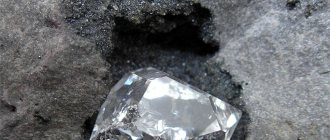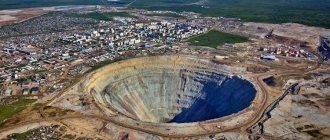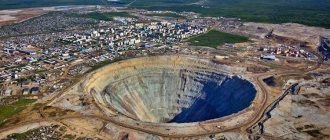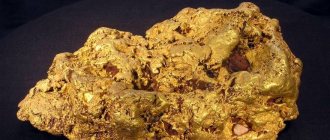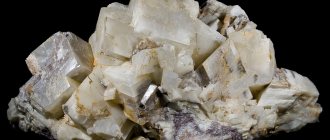The formation of diamonds from carbon occurs at a depth of 150-200 kilometers at a temperature of 1100-1300 degrees Celsius and a pressure of 40-50 kilobars. Under these extreme conditions, the carbon atoms arrange themselves into a cubic crystal lattice, providing the strength and hardness of the mineral. Their deposits have been found on almost all continents of the world. The largest are located in South Africa - in South Africa, Congo, Namibia, more than 50% of all stones circulating on the world market come from here; these are the purest and most valuable minerals.
Advertising - Continued below
The Mir kimberlite pipe is 525 meters deep and 1.2 kilometers in diameter (Mirny city).
Diamonds are thrown onto the surface of the earth by volcanic explosions along with magma, thus forming so-called kimberlite pipes, which are a mixture of magma and diamonds, which go deep into the earth like a wedge. Such deposits are called primary deposits. Together with groundwater, diamond crystals are washed out of the bowels of the earth and settle in the beds of rivers and lakes near the deposits; these areas are called diamond placers.
For many years, diamonds were not mined in mines, but only in placer deposits by washing river sand. Until the beginning of the 18th century, all explored deposits were located in India. In 1725, diamond placers were discovered in Brazil; by this time, Indian deposits had been depleted, and South America became the leader in diamond mining.
The first diamond deposits in the form of a kimberlite pipe were found in South Africa in 1867 on the Orange River, which radically changed not only the way diamonds were mined, but also the lives of the South African people. South Africa at that time was a British colony, and the mining was carried out by about 2,000 English prospectors, who then transported the stones to London. In 1888, the most profitable areas were bought up by large entrepreneurs with financial assistance from the House of Rothschild, who then merged into the De Beers company known today. By the beginning of the 19th century, the development of deposits was carried out not only in the south, but also in the east of Africa, in the territory of the German colonies. To date, one of the most significant finds in South Africa is a 29-carat blue diamond found in the Cullinan mine, which was subsequently sold for $25.6 million.
Advertising - Continued below
Diamond mining in the Udachnaya pipe in Yakutia
Diamond mining is a labor-intensive process that requires large financial investments. Before the first stone is found, it is necessary to spend years searching for a deposit, and then the same amount on purchasing equipment and preparatory measures.
Kimberlite pipe
A huge hole in the ground is a diamond quarry. It is located on a kimberlite pipe, which was formed millions of years ago as a result of the eruption of fiery lava from the depths of the earth. It is shaped like a glass. This deposit was discovered in 1955.
Soviet geologists assumed that in these harsh places there were deposits of kimberlite, an ore containing diamonds, so intensive searches were carried out. But the deposit was discovered by accident. A fox dug a hole under a pine tree torn up by a hurricane. The soil contained kimberlite.
How to wash, rinse and dry a blanket without a washing machine: complete instructions
You can make a beautiful kitchen apron with your own hands: we use tiles for it
Astronomers have found the reason why aurora appears on Jupiter
A coded urgent radiogram flew to Moscow. A few days later, caravans of heavy equipment moved to these places. Permafrost and extreme climatic conditions presented a huge challenge. Incredible efforts were not in vain; a rich diamond deposit was discovered.
Links[edit]
- Diamond Mine on Wikimapia
- Diamond mine. Photo gallery
- Diamond mine. Another photo gallery
| [ + ] Diamond mine | |
| Komi Republic | Vorgashorskaya • Vorkutinskaya • Zapolyarnaya • Intinskaya • Komsomolskaya • Northern |
| Rostov region | Almaznaya • Anthracite • Vostochnaya • Gukovskaya • Dalnyaya • Zamchalovskaya • Obukhovskaya • Rostovskaya • Sadkinskaya • Sherlovskaya-Naklonnaya |
| Republic of Khakassia | Khakassian |
| Yakutia and Chukotka | Nagornaya • Denisovskaya • Dzhebariki-Khaya • Ugolnaya |
| Sakhalin and Primorye | Oriental Pearl • Northern |
Diamond deposit "Mir"
2 kg of diamonds were mined here per year, 1/5 of which were of the highest quality. Beautiful jewelry was made from them. The remaining diamonds were used for the needs of instrument making. For production, unique technologies were used that did not use water, which was impossible in the conditions of the Far North and permafrost.
The ore processing plant is located on solid ground 20 km from the mine. The size of the crater is so huge that helicopters are strictly prohibited from flying over it, since the downward air currents pull cars into the crater.
A spectacular dessert from matches: bake pancakes, roll them into a roll and fill them with cream
Mystery of the keys: one hundred cars stopped working in a supermarket parking lot
Russian schools plan to start the next academic year in full-time format
In order not to collapse the diamond market, the largest South African company, De Beers, bought them in bulk. The scale of diamonds mined confused the company's management. The desire to see everything with my own eyes haunted me.
A letter was sent to the Soviet government with a request to allow the company’s specialists to come to Mirny. Permission was received, but the schedule of the delegation’s stay was structured in such a way that foreign guests were at the field itself for only 20 minutes. What they saw literally shocked their foreign colleagues.
The largest diamond quarry in the world
In Yakutia, near the city of Mirny, there is the largest diamond quarry in the world by total volume - the Mir kimberlite pipe (the city of Mirny appeared after the discovery of the pipe and was named in its honor). In Yakut folklore there is a legend that one day, flying over Yakutia in the winter cold, God got frostbite on his hand and dropped a bag of precious stones. They scattered across the mountains, river valleys and tundra. But for a long time, gold and diamonds, which Yakutia is so rich in, remained unavailable. And it’s not surprising: in Yakutia there is the pole of cold of the Northern Hemisphere (a place where in winter the temperature reaches minus 70 degrees). But in the 50s of the last century, Yakutia revealed to man a unique diamond cache, transformed by several generations of diamond miners into a giant quarry. The quarry has a depth of 525 meters and a diameter of 1.2 kilometers.
“Mir” is the diamond capital of Russia, the city where a quarter of all diamonds on the planet are mined. It was here that industrial diamond mining began for the first time in our country 45 years ago.
The formation of a kimberlite pipe occurs during a volcanic eruption, when gases from the bowels of the earth burst out through the earth's crust. The shape of such a tube resembles a funnel or glass. A volcanic explosion removes kimberlite, a rock that sometimes contains diamonds, from the depths of the Earth. The breed is named after the town of Kimberley in South Africa, where an 85-carat (16.7 gram) diamond was found in 1871, sparking the Diamond Rush.
The beginning of total diamond mining in Yakutia was marked by the Cold War. At that time, the need for strategic raw materials used in the defense industry sharply increased in the Soviet Union. To purchase it abroad, the country needed funds that could be obtained from the sale of precious stones that had already become famous on the world market. However, the insignificant deposits of precious stone in the Urals could not satisfy the demands of the Soviet government for the necessary funds. Some Soviet scientists never ceased to assert: there are signs indicating the presence of diamond deposits in the Yakut land.
On June 13, 1955, geologists searching for a kimberlite pipe in Yakutia saw a tall larch tree whose roots had been exposed by a landslide. The fox dug a deep hole under it. Based on the characteristic bluish color of the soil scattered by the fox, geologists realized that it was kimberlite. A coded radiogram was immediately sent to Moscow: “We lit the peace pipe, the tobacco is excellent.” Soon, through 2,800 kilometers of off-road terrain, convoys began to reach the discovery site of the kimberlite pipe. The working village of Mirny grew up around the diamond deposit; now it is a city with a population of 36 thousand people.
The development of the field took place in extremely difficult climatic conditions. To break through the permafrost, it had to be blown up with dynamite. In the 1960s, 2 kilograms of diamonds were already produced here per year, of which 20% were of jewelry quality and, after cutting and turning into diamonds, could be supplied to a jewelry salon. The remaining 80% of diamonds were used for industrial purposes. South Africa was concerned about the rapid development of Mir, which was forced to buy Soviet diamonds in order to control prices on the world market. The management of De Beers agreed on the arrival of its delegation in Mirny. The leadership of the USSR agreed to this on the condition that Soviet specialists would visit diamond quarries in South Africa. A De Beers delegation arrived in Moscow in 1976 to fly to Mirny, but the South African guests were deliberately delayed by endless meetings and banquets in Moscow, so when the delegation finally reached Mirny, they had only 20 minutes to inspect the quarry. However, South African experts were still amazed by what they saw, for example, by the fact that the Russians did not use water when processing ore. Although this is understandable: after all, 7 months a year in Mirny there is sub-zero temperature and therefore the use of water is simply impossible.
Between 1957 and 2001, the Mir quarry produced $17 billion worth of diamonds. Over the years, the quarry expanded so much that trucks had to travel 8 kilometers along a spiral road from the bottom to the surface. The Russian company ALROSA, which owns the Mir quarry, stopped open-pit mining of ore in 2001, as this method had become dangerous and ineffective. Scientists have found that diamonds lie at a depth of more than 1 kilometer, and at such a depth, it is not a quarry that is suitable for mining, but an underground mine, which, according to the plan, will reach its design capacity of one million tons of ore per year already in 2012. In total, the development of the field is planned for another 34 years.
Helicopters are strictly prohibited from flying over the quarry, as the huge funnel sucks aircraft into it. The high walls of the quarry are fraught with danger not only for helicopters: there is a threat of landslides, and one day the quarry may swallow the surrounding, including built-up, areas.
“Scientists are thinking about a project for an eco-city in a now empty huge pit. The head of the Moscow architectural bureau Nikolai Lyutomsky talks about his plans: “The main part of the project is a huge concrete structure, which will become a kind of “plug” for the former quarry and will burst it from the inside. The pit will be covered on top with a translucent dome on which solar panels will be installed. The climate in Yakutia is harsh, but there are many clear days there and the batteries will be able to generate about 200 MW of electricity, which should more than meet the needs of the future city. In addition, you can use the heat of the Earth. In winter, in Mirny the air cools to -60 degrees, but at a depth below 150 meters (that is, below permafrost), the ground temperature is positive, which adds energy efficiency to the project. The city space is proposed to be divided into three tiers: the lower one - for growing agricultural products (the so-called vertical farm), the middle one - a forest park zone that purifies the air, and the upper one for the permanent residence of people, which has a residential function and serves to house administrative and socio-cultural buildings and structures. The total area of the city will be 3 million square meters, and up to 10,000 people will be able to live here - tourists, service personnel and farm workers."
The quarry has now been converted into a local landmark. An observation deck and a memorial sign are installed above it.
Sources:
https://gorizontsobytij.ucoz.ru
https://udivitelno.com
City Mirniy
The diamond deposit gave its name to the city on the permafrost, which eventually grew not far from it. Today, the crater, striking in its scale, is located within the city. In 2004, open pit mining was closed. But not because of the depletion of the deposit, but because of the danger of further open-pit mining. After all, the total length of the road running along the slope of the pit is 8 kilometers.
Its exploitation creates the danger of a gigantic landslide that could drag the city down with it. After all, it does not stand on solid ground, but on permafrost. Today, kimberlite ore is mined from an underground mine. According to scientists' calculations, the kimberlite pipe goes one kilometer deep.
Found a violation? Report content
Rating of producing countries
1st place - Botswana Mines: "Letlhakane" (cost of 1 carat - $200, diamond content in ore - 29 carats per ton of ore), "Jwaneng" ($110 per carat, 140 carats/ton), etc.
Advertising - Continued below
2nd place - Russia Mines: “Udachnaya” ($55 per carat, 120 carats/ton), “Nyurba” ($55 per carat, 90 carats/ton), etc.
3rd place - Canada Mines: Ekati ($140 per carat, 100 carats/ton), Diavik ($88 per carat, 372 carats/ton), etc.
4th place - South Africa Mines: Veneshia ($90 per carat, 122 carats/ton), Premier/Kulilinan ($75 per carat, 40 carats/ton), etc.
Advertising - Continued below
5th place - Angola Mines: Catoca ($75 per carat, 45 carats/ton), Diavik ($88 per carat, 372 carats/ton), etc.
Where are the largest mines?
When the world's gold rush boom subsided, mostly time-tested deposits remained in development. In addition to the countries of South America and Siberia, gold is primarily actively developed and mined in the mines of the South African Republic. This is where the vast majority of mines are located. And not surprisingly, they turn out to be the largest mines in the world. So, let's count. The depth of the Tau-Tona mine, near Johannesburg, is 5000 m. Yes, yes, a 5000-meter long tunnel goes vertically down into the earth! Timothy Greene, author of a wonderful book on gold, wrote: “Diving into a gold mine is like traveling into the realm of Pluto.” Descent into darkness and depth.
Gold mines can be very deep
Tau-Tona has been in operation since the mid-20th century, more precisely, since 1962, and this “Great Lion” (as the name of the mine is translated) was built for 5 years - since 1957. Up to 6 thousand people experience the 55-degree heat of the 5-kilometer mine miners, 120 people at a time going down there in a cage - a special elevator. To date, she has enriched her owners by 1200 tons of gold.
In the same South Africa there are also mines that are not much inferior to Tau-Tone: Witwatersrand (4.5 kilometers deep); “Western deep mine” - 3.9 kilometers; Mponeng – 3.8 km. All these mines are actively producing gold. So the gold rush continues in South Africa.
The deepest Tau-Ton mine in the world is located in Africa
The deepest mine in Russia
What about us? In Russia, 11 km from Vorkuta there is a Komsomolskaya mine. It is believed that it is the deepest mine in Russia. It produces coal at a depth of 1100-1200 meters. The mine was founded in 1977. Type K coal, i.e. coke coal, is also mined here. Scientists expect to use this mine until 2022. There will be enough coal there for so many years of active mining.
The deepest mine in Russia is Komsolskaya. It is located near Vorkuta
Kuzbass is also rich in coal mines. Of course, the famous Raspadskaya mine in the Kemerovo region is inferior in depth to its Ukrainian “colleagues”, but, nevertheless, it is the largest and deepest in Russia. 10% of Russian hard coal from Raspadskaya, which began its history in 1973. Unfortunately, one of the largest mining accidents, tragic for 91 families of miners, happened there in May 2010.
Deepest coal mine
Our neighbors have the deepest coal mine - Ukraine is the leader here. The Shakhterskaya – Glubokaya mine has a depth of about 1.5 kilometers, or more precisely 1546 m. Donetsk region, a city with the “speaking” name Shakhtersk, is its address. Built in 1986. Newspapers wrote then that Shakhterskaya was the deepest mine in the USSR. There, in the Donetsk region, called the coal basin, there are mines that are not much inferior to the giant: “Progress”, named after. Skochinsky, them. Bazhanova...
The city of Shakhtersk has the deepest coal mine
"Progress" (1340 m deep) promises to produce about 100 million more tons of coal. The coal mined there is called anthracite, a very high-quality product. This mine is also very hot, but not as hot as in Africa. Here the temperature rises to 40 degrees. About 1800 people work here.
Mine named after A.A. Skochinsky (1200 m) is a technically very equipped mine. At one time it was considered the deepest mine in the world. This was in 1975. It has a “bad reputation” due to the fact that a very large number of accidents have occurred here. This is due to the peculiarity of the coal seam in this area. More than a hundred people died at this enterprise.
The Progress mine is considered large
Mine named after V.M. Bazhanov (1200 m) with 70 million tons of coal. By the way, it has not been reconstructed since 1957, when it was built. Coke coal is mined here and used to produce cast iron. If we can say that South Africa is the “mistress of gold,” then Ukraine is the “queen of coal.”
Mine named after V.M. Bazhanov, more than a kilometer deep, has not been reconstructed for more than half a century



